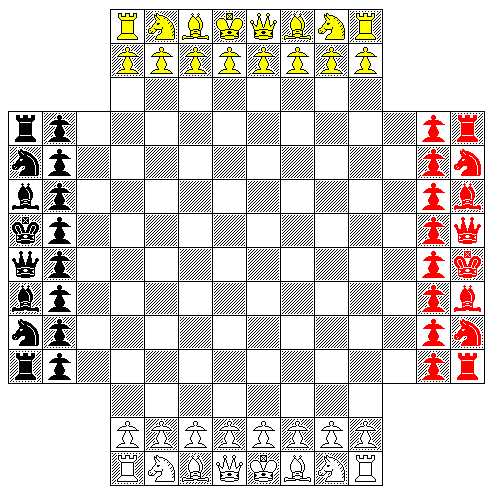
The section of my site dealing with Chess is divided into several parts; the first two deal with the normal game of Chess itself; the first with the game as it is, and the second with some suggestions of mine that involve changes to matters such as scoring; and the next three deal with pre-existing forms of Chess; the first with traditional forms played in other lands, and the next two with various invented forms of Chess; and the final section deals with variations of Chess of my own invention. That being said, this page may perhaps be viewed as splitting the difference, as I have placed versions of four-player Chess of my own invention along with pre-existing forms.
Its topic is Chess for four players. The board for the version I will be discussing first

is that used by Captain George Verney for his version of four-player Chess. A version with rules modified from his, by M. E. Hughes-Hughes, remained popular for many years. Rules for traditional four-player Chess have often appeared in those books, descended from that of Hoyle, that give the rules for numerous card games, and a very few of the most traditional board games, such as Chess, Checkers, and Backgammon, which makes it far less exotic, and far more well-known, than almost any other Chess variant.
Upon looking into the forms of four-player Chess that had been proposed over the years, it seemed to me that they described a game sufficiently different from ordinary two-player Chess as to be somewhat off-putting to many. Certain common aspects of Pawn promotion were part of it, but the main and most persistent difference was the requirement to achieve a simultaneous mate of both opponents, usually through first mating one opponent, and holding that mate until the other opponent is also mated.
Thus, I propose a rather different form of four-player Chess than the usual version.
The arrangement of pieces shown above has all the Queens on white squares. This means that the White and Yellow Queens are both to the left of their King, while the Black and Red Queens are both to the right of their King. While this arrangement may seem confusing, it has the advantage that no player's King is on the same diagonal as an opponent's Queen on her home square, which means that advancing the Queen's Pawn (or the King's Bishop's Pawn) does not put a player at immediate risk of checkmate.
Pawns promote when they reach either the eight squares of the back rank of the team opposite to them, or the two groups of three squares on either side beyond which no further advance is possible. Castling, the two-step Pawn first move, and en passant capture are also as in normal Chess.
The turn is passed counter-clockwise, first White, then Red, then Yellow, then Black. (This was the direction used in the earliest forms of four-player chess, although the trend shifted overwhelmingly to clockwise early on.)
First, here are the special rules for the partnership game.
A King is not considered to be checked if it is en prise to a piece on its partner's team; and it is never possible for a piece of one side to capture a piece belonging to a partner, not even to avoid or escape from checkmate, any more than it would be possible to capture a piece on its own side.
When both teams of a partnership are on the board, and one of those teams is stalemated or checkmated, that team must still make a move on its turn, even though that move will leave the King in check. When the first of the two Kings of the two teams of a partnership is captured, then all the other pieces belonging to that team are removed from the board.
When only one team of a partnership remains, then that team loses when checkmated normally, and stalemate is a draw.
In the game of four players, each team looking out for itself, the object is to eliminate two teams from the board by capturing their Kings, and then when the board is reduced to any two teams, the stalemate and checkmate rules of Chess apply normally.
These rules differ considerably from those of the usual form of the four-handed game; in that, the normal convention is that after a checkmate, the checkmated player's pieces remain on the board, and the pieces giving the checkmate must remain in place, or be relieved by other pieces, else the formerly checkmated player can return to the game.
This has the advantage of tying up some of the pieces of the partnership that now has two sets of chessmen, and two moves, to the one of the remaining player on the other side. In this way, victory for one side is not so easily and suddenly achieved, adding to the challenge of the game.
But while those are laudable goals, Chess is challenging enough as it is, and, thus, I feel that the gain resulting from making the game simpler and more natural in terms of the ordinary two-player form of Chess outweighs the loss of some additional challenge.
Note that while this largely eliminates the relief of checkmate as a feature of the game, when it is required to capture the King to eliminate a player, some possibility of relieving mate still exists. For example, in the partnership game, when one of two active players in a partnership is either checkmated or stalemated, since that player must still move, he may choose to move so that the King is in check not from the opponent that will move next, but the other opponent, that will move after his partner. The partner could then prevent the capture of the King by removing the check, either by capturing the checking piece, or by interposition, or by giving check to the King of that opponent. In the latter case, that player would have to remove is own King from check before he could consider capturing another player's King, unless, of course, capturing the other player's King, causing that player's men to be removed from the board, was a way to escape from check, or, unless he was not merely in check, but was checkmated, in which case he would still have to move, and could choose from the moves that would leave him in check.
The same basic considerations are also applicable in the game where all players are independent, even if they are less likely to be relevant.
Another common feature of existing four-player forms of Chess is some rule to prevent the advance of a Pawn from being blocked by a Pawn belonging to its partner's team. Given the long distance Pawns must advance to promote, it seems to me that they stand enough chance of being captured to make such a provision unnecessary.
However, if such a rule is needed, I would like to suggest one that differs from those which have been previously proposed. What I would suggest is this: a Pawn may move in the manner it would normally move in to capture a Pawn belonging to its partner's team, but instead of being captured, that Pawn will either exchange places with the "capturing" Pawn, being placed on the square from which it started its move, or, in the case of en passant capture, simply remain undisturbed without moving.
In this way, Pawns of teams in partnership can pass each other without adding a completely novel type of move to the game, the move instead being based as closely as possible on the pre-existing Pawn capture rules of conventional Chess.
While there are many versions of the conventional four-player game, the general features of their rules are:
The game described above differs significantly from this pattern.
There is at least one commercial version that I know of (the one by Taurus Games, a sponsor of The Chess Variant Pages) that gives an alternative set of rules in which the object is to capture the Kings of the opponents' teams, with each team being removed from the board when this is done; what I propose is in that direction, but goes only half as far: it changes the rule to capture of the King when necessary to avoid the need for simultaneous mates, when more than one opposing player remains in the game, but retains stalemate as a draw when doing so presents no problems.
Removing the pieces of a checkmated player from the board before the other player in the partnership is checkmated was proposed as an alternate rule by A. Demonchy in 1856 for four-player Chess on the board with 8 by 2 extensions, and is a feature of the commercial four-player game Intense Chess.
The normal rule in Demonchy's game was to remove only the King from the board, and this has given me the idea to propose an alternate rule which I believe might be genuinely unique and original.
The alternate rule is: when the first player of a partnership is defeated by the capture of the King in the turn following an unrelieved checkmate or stalemate (or, perhaps, in a later turn for some reason, such as a check), only the King is removed from the board, and the remaining pieces of that player are added to the forces of the other player of the partnership. Subsequently, the remaining players play in their turns, and defeated players do not have a turn; therefore, when one player's King is removed from the board, the other player of that partnership may either move one of his own pieces, or one of those of his defeated partner.
Thus, when the King of one of the players is removed from the board, under the alternate rule, except for the King, his forces are not lost, but his turn is lost.
The rule that the pieces of a checkmated side are removed from the board is also a feature of one of the oldest versions of four-player Chess (although, of course, four-player Chaturanga is much older yet), the Russian four-player Fortress Chess, which is played on a board with the following appearance:
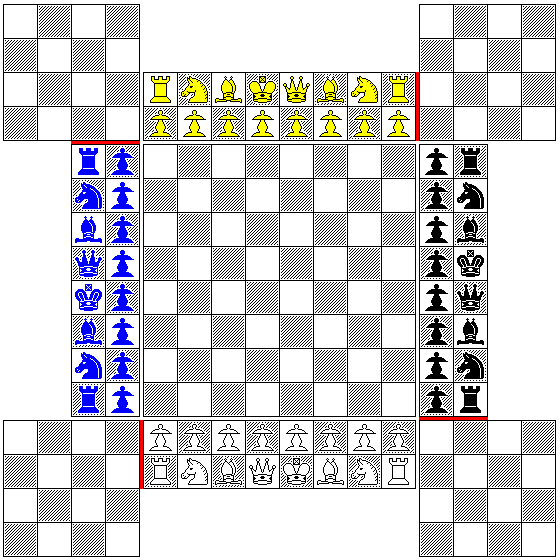
The small gaps between segments of the board do not affect movement, except for the heavy red lines, for which those gaps created room, which act as a complete barrier to all movement, just as the edge of the board does.
These barriers restrict access to the 4 x 4 square areas in the corners of the board, which are called fortresses. In the initial setup, each player places a third Rook, a third Bishop, and a third Knight anywhere within the fortress to the right of his initial array. While this fortress is the one most conveniently placed to shelter the pieces of that player, except for the barriers, it is a normal part of the board, and any player's pieces may enter it, provided the approach is made from a direction not blocked by the barrier.
Pawns cannot capture the Pawns that appear en prise to them in the initial layout. For determining whether or not a Knight move is prevented by the barrier, the Knight's move is thought of as being composed of one orthogonal step followed by one diagonal step. The Queen also moves as the Knight, this being the Queen move in normal Chess in Russia at the time of this game's invention. Allied pawns that meet head on are simply blocked until a capture intervenes.
Originally, I had proposed a novel arrangement of the pieces, which I had chosen because of its resemblance to that of normal Chess, for the partnership game, and for the all-play-all game, I chose the symmetrical arrangement in which the King is always to the right of the Queen.
In the new arrangement I had originally suggested, as in conventional Chess, the Kings of the two players seated opposite each other are on the same file. (This has the consequence that the black Queen and the white King, as well as the white Queen and the black King, lie along a diagonal, and the same is true of red and yellow.)
The rule for setting up the pieces for the partnership game is a modification of "Queen takes her own color", so that the rule applies within each partnership. One partnership consists of the White and Yellow pieces, both light-colored, but since Yellow is the darker of the two, the Yellow Queen goes on a black square; the other partnership consists of the Black and Red pieces, both dark-colored, but since Red is the lighter of the two, the Red Queen goes on a white square.
But that arrangement would mean that White and Red need to be careful of advancing their Queen Pawns, and Black and Yellow need to be careful of advancing their King's Bishop Pawns, because of the risk of exposing their Kings to attack from an opponent's Queen along a diagonal.
When all four Kings are to the player's right of their respective Queens, all four players need to be careful of advancing both their Queen Pawns and their King's Bishop's Pawns: this is the arrangement of pieces that seems to be seen more often in more recent versions of four-player chess.
As it is the arrangement where all four Queens are on squares of the same color is the one which eliminates this problem, since in that one the Queens always face each other diagonally, I had to admit that it was the best arrangement, preferable to the one I had originally proposed. This was the original arrangement for the four-player game, later abandoned in favor of placing the King always to the right of the Queen.
However, while I learned that my original proposed array for the game was flawed, because it did not deal with this issue as well as the original one with all the Kings on the same color, I have since learned that the array with all the Kings to the right of their respective Queens has something to commend it as well; by leading to play in which all four players usually begin by advancing their King's Pawn, it tends not to favor the first player to the extent that the one with all Kings the same color appears to. Whether the array I initially proposed would yield the worst of both worlds, or perhaps a game intermediate between the two established arrangements (by leaving two, rather than three, or just one, initial Pawn moves available to each player of those which can potentially be affected), or is of some genuine merit was unclear to me as I initially prepared this page.
But I have now come up with a possible use for an arrangement of that general type, but with the colors of the pieces re-arranged:
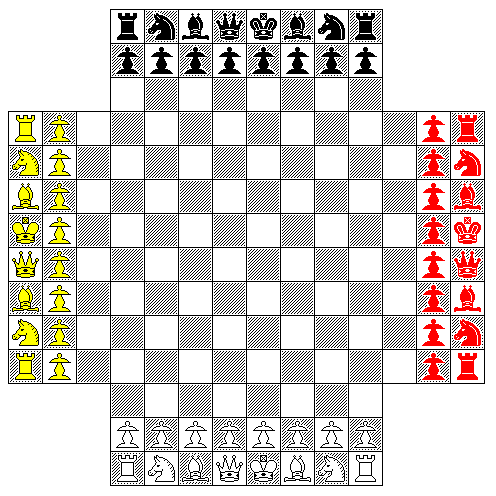
This version of four-player Chess is an attempt to obtain a game that even more closely resembles ordinary two-player Chess than the version described above. However, some might view these versions as proving that the more I try to make a four-player Chess that resembles ordinary Chess closely, the further away I actually end up.
With the board above, the turn again passes counter-clockwise, from White to Red, then Black, and finally Yellow.
The most important special rule of this version of four-player Chess is that the White men may only capture Black pieces, and vice-versa, and the Red men may only capture Yellow pieces, and vice versa. As well, only White may give check to Black, and so on.
To the Black and White pieces, the Red and Yellow pieces simply act as blocks to movement, and vice versa, the same way that one's own pieces block one's movement. Note that, for this reason, this game may also be played on the board with 8 by 2 extensions, to which it is more eminently suited than ordinary forms of four-player chess:
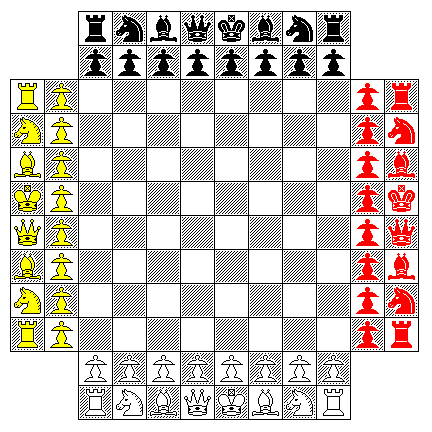
Despite this, White and Yellow play as partners against Red and Black.
White and Black play what is basically an ordinary game of Chess against each other, with checkmate the object, and stalemate a draw, and Red and Yellow do the same on their turns. Each individual player may win, lose, or draw, and a team wins when it scores either two wins or a win and a draw. Two draws, or a win and a loss, make a draw for the team.
When one of the two games of Chess being played reaches a conclusion, whether through checkmate, resignation, stalemate, draw through repetition of moves, insufficient force, or draw by agreement, or the 50-move rule as modified below, the pieces of both teams involved in that game are removed from the board, the winner as well as the loser. The 50-move rule is modified as follows: for the 50 moves involved, there must not be a Pawn move or capture by all four players, not merely the two involved in the draw.
Also, castling and the double-step first move of the Pawn, as well as en passant capture, all work as in normal Chess.
The Red and Yellow players only, because their move is followed by a move on the part of their partners, have the privilege of moving their Kings into check, but if their partner fails to relieve that check, they can then lose their individual game if their individual opponent then captures their King on the next move.
Further, this privilege of moving into check is affected by the following additional conditions:
Whether these rules result in a game of four-player Chess which more closely resembles two-player Chess, or something that is more outrageously and bizarrely different therefrom is likely a question whose answer depends on individual taste.
Essentially, the strategy of this game is envisaged as being the following: White and Black will play against each other as in normal Chess, and Red and Yellow will do the same, but each player will also be mindful of assisting his partner through the fact that his pieces serve as blockades in the game in which his partner is involved. That does not mean, though, that teamwork is only of marginal importance.
A noted chessplayer once said of a conventional version of four-player Chess that it "makes a marvelous double-dummy game". That could be taken as a condemnation of four-player Chess through the very faintness of the praise therein, since conventional Chess is a similar and better two-player game, so why bother; but then, there's nothing wrong with variety in two-player games. This version of four-player Chess, though, whatever other virtues it may posess, seems to me to lack that particular ironic virtue, and would be poorly suited to use as a two-player game with one player playing both sets of pieces in a partnership.
In this connection, the game called Double Chess, proposed by J. T. Howard may be noted.
In this game, the pieces are arranged as follows:
Black R R Red
N P P N
B P - - P B
K P * * * P Q
Q P - - - - P K
B P * * * * * P B
N P - - - - - - P N
R P * * * * * * * P R
P - - - - - - - - P
* * * * * * * * *
- - - - - - - -
* * * * * * * * *
p - - - - - - - - p
r p * * * * * * * p r
n p - - - - - - p n
b p * * * * * p b
k p - - - - p q
q p * * * p k
b p - - p b
n p p n
White r r Yellow
where * denotes an empty dark square, and - an empty light square.
The board is shown diagonally, as it was in his book, because this is a game for two players, one controlling the Black and Red pieces, the other controlling the White and Yellow pieces.
On the first turn, Light makes one move with one White piece or one Yellow piece.
On even-numbered turns, Dark makes two moves, one with a Black piece and one with a Red piece, in either order, never two moves with pieces of the same color.
On odd-numbered turns after the first turn, Light makes two moves, one with a White piece and one with a Yellow piece, in either order, never two moves with pieces of the same color.
(In the rules as given, Dark can also move first, unlike the case in normal Chess.)
This, clearly, is aimed at equalizing the advantage of the first move as between Light and Dark.
A game is drawn when any King of either side is stalemated.
When one King is checkmated, as long as it remains checkmated, the pieces of that color are immobile.
The object is to checkmate the two Kings of the opposing player.
Pieces of the other light or dark color do not give check, nor may they capture, pieces from the other set controlled by the same player.
A move that exposes either of one's Kings to check is illegal even if it is made with a piece belonging to the other set one controls.
This seems like a very natural two-player game on the four-player board, although I would have switched the positions of the King and Queen on both the White and Yellow sets to more closely resemble conventional Chess.
We've already seen Chaturaji, the early four-handed Chess game that was contemporaneous with the original form of Chess, Chaturanga:

There was also the Chess of the Four Seasons (spelled, in the famous manuscript prepared for Alfonso X in 1283, as "Acedrex de los Quatro Tiempos") - which, like Chaturaji, could also be played using dice to indicate which piece could be moved:
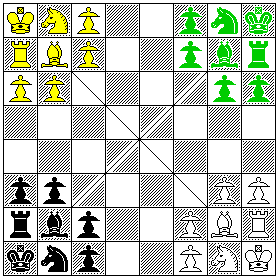
Pawns did not have a double-step first move. The direction in which a Pawn moved could be derived from the part of the board in which it was located - each player having two Pawns that moved in one direction, and two Pawns of the same color that moved in another.
When one player was checkmated, that player's pieces remained on the board immobile as the game continued.
Turns passed counterclockwise from one player to the other.
When this game was played with dice, the numbers indicated which piece could be moved as follows:
1 Pawn 2 Bishop 3 Knight 4 Rook 5 -- 6 King
with the throw of 5 corresponding to the Queen, which is not present in this game.